Stock Cost Basis Illustrator
This illustrator helps learn about the effect of different cost basis
methods on stock sale gains. See
Investing in Stock - 9: Stock Cost Basis Methods to understand cost basis.
Disclaimer
This tool is only meant as an illustration:
- It uses only the stock's buy price and the duration the stock was held.
- It simulates any rise or fall in the stock's value.
- It does not take into consideration other factors that go into calculating cost
basis (such as stock splits, dividend reinvestment, vesting period -
in the case of stock options, etc.).
- Use the illustrator to learn about the different cost basis methods.
- Don't use it for your tax planning! Your total tax depends on various things and not just on stocks.
Assumptions
To focus on the effect of cost basis methods alone and to keep
things simple, we make the following assumptions:
- There were no stock splits between the time we bought the stock
and when we sold it.
- No dividends were paid out.
- We only take into account only whole years.
Number of (continuous) years that we bought this stock.
Number of shares bought each year. We assume that the same number of shares are bought every year.
We buy the shares in year 1. This field indicates the share price in the year we bought this stock.
Annual gain/loss range in share price that we want to simulate. Every year we choose a random value in this range. (To have a fixed gain/loss, specify both the minimum and maximum value to be the same.) We simulate the share price going up or down each year by this percentage and that, when we buy or sell shares in a year we do so at that year's simulated price.
Number of years we wait after the last purchase year before we start selling. If starting to sell the year after the last buy, specify as 0.
Number of (continuous) years that we sold this stock. If all stock was sold in a single year, specify as 1.
Number of shares sold each year. We assume that the same number of shares are sold every year.
Specify whether to sort the report by cost basis method or by year.
Tax rate percentage to apply for stock held for less than the short-term period.
Short-term period in years. Gains on selling shares held for less than this period will be taxed at the short-term capital gains tax rate. Gains on shares that were held for this or longer duration will be taxed at the long-term capital gains tax rate.
Tax rate percentage to apply for stock held for at least or longer than the short-term period.
